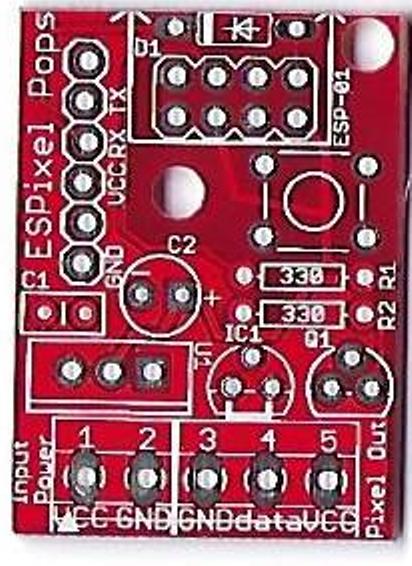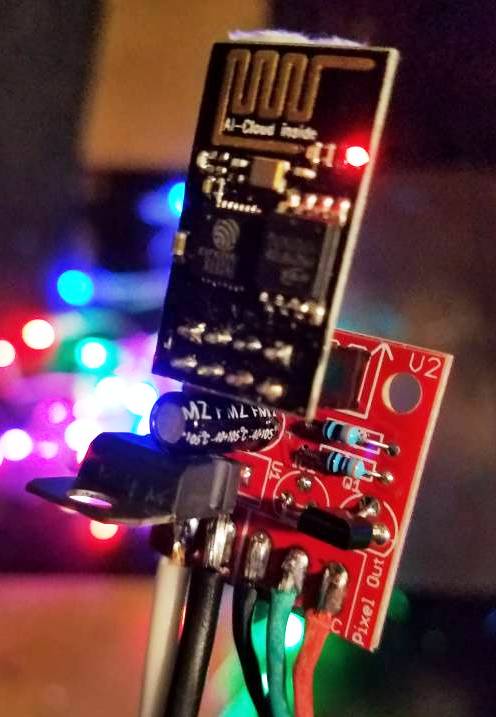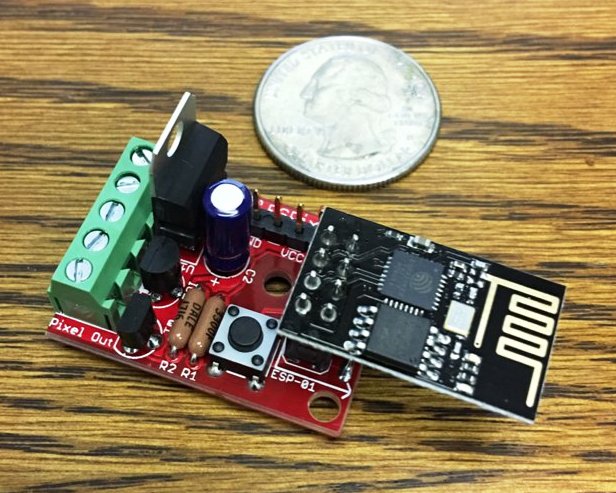ESPixel Stick & ESPixel Pops: Difference between revisions
Ukewarrior (talk | contribs) |
Ukewarrior (talk | contribs) |
||
| Line 130: | Line 130: | ||
The board has a place for a second voltage regulator. This is to accommodate 5V pixels even if your input power is 12V. | The board has a place for a second voltage regulator. This is to accommodate 5V pixels even if your input power is 12V. | ||
<br> | <br> | ||
This is location IC1 on the board. This is a spot for either a 5V regulator or a wire jumper. | This is location IC1 on the board. This is a spot for either a 5V regulator or a wire jumper.<br> | ||
<br> | |||
To summarize the population of the voltage regulators:<br> | |||
The part labeled: Q1 is always installed.<br> | |||
The part labeled: IC1 is installed if you are running 12V Pixel strings<br> | |||
The part laveled: IC1 is NOT installed if you are running 5V Pixel strings AND you must place a jumper in its place as noted on the board.<br> | |||
== Wiring The ESPixel Pops == | == Wiring The ESPixel Pops == | ||
Revision as of 02:55, 20 October 2017


The ESPixel Pops and ESPixel Pops Tiny are variations of the original ESPixel Stick by Shelby Merrick
The original "ESPixelStick" is the open source firmware and hardware created by and as a successor to Shelby Merriicks nRF24L01 based PixelStick project.
Bill Porter happened to be working on his Renard ESP and GECE controllers at the same time which also utilize the same ESP8266 ESP-01 module.
Shelby, Bill and a few others have worked since then to broaden functionality and support of the firmware for these devices.
As a result, there is one common firmware thread that works on all of the ESP-01 based DIYC pixel sticks as of 10/1/2017.
You can read about this at Bills website found at: The mind of Bill Porter
You can read further at Shelby's website found at: Shelby's Forkineye Website
The boards discussed in this wiki are derivations of a design by Bill Porter.
The full discussion thread regarding these boards is found at DIYC at this thread:
Click Here:
The ESPixel Pops is the most basic of the Pixel Stick designs. It is a fully through hole PCB with no smd(surface mount) components. Therefore, it is easily built by most anyone with basic soldering skills.
This variation was created by Pops Electronics (ukewarrior) in order to create a form factor that would fit inside a 1" thin wall PVC tube.
From a software perspective, it is an E1.31 sACN (Streaming ACN) pixel controller that connects over a standard (802.11g/n) WiFi network. The firmware is open source and developed in the ESP8266 Arduino environment. It provides a web based configuration front-end and currently supports WS2811 / WS2812 pixels. (3-wire pixels)
General Features

The Pixel Pops has these main features
1. It supports 3 wire pixels such as those based on 2811, 2812 and GECE chipsets
2. It runs as a wireless E 1.31 datastream from your main controller (aka show computer)
3. It utilizes the ESP-01 module for processing and wireless operation
4. It supports both 5v and 12v pixels
5. The board is small enough to fit inside a 1" thinwall PCB pipe with the PCB measuring only 24.18x33.32 mm and 24.18x24.61 mm for the tiny version. This type of pipe is listed as SDR-21.
Click here for a Lowes example: Thin all 1" PCV pipe
The board is professionally manufactured with 1oz copper and the holes are through plated. This makes for easy and more error free soldering.
All wires attach via terminal blocks. However, the use of terminal blocks is optional as the holes support direct soldering of wires.
The Schematic can be downloaded by clicking on this link:
Media:ESPixel_PopsSchematic.pdf
.
Order your own boards
Contact ukewarrior via a PM on DIYC as he often has boards in stock, cheap !
You can also order them in groups of 3 from OSHPark: Click here for the Ordering link at OSHPark to order your own boards
Fuses
There is no onboard fuse for the ESPixel Pops.
Since there is no onboard fuse, if a power overload should occur, the ESP-01 or the ESPixel Pops board may be damaged. You can add an inline fuse if desired with the input power feed.
Disclaimers
USE the ESPixel Pops board at Your Own Risk !
The ESPixel Pops board has NO warranty expressed or implied
BOM - Bill of Materials
The BOM contains these generically described parts:
- One ESP8266-01, this is not so much a part, but a complete subassembly.
- One diode. This must be: 1N4148
- One female socket header, 2 rows of pins, 4 pins in each row. This functions as the socket where you plug the ESP8266 module into
- One six pin header. Readily available 2.54mm (.1") pitch. (distance between the pins)
- One tactile switch. 6mm x 6mm. Also readily available. These often have choices as to the height of the push button.
- Two 1/8W or 1/4W carbon film or metal film resistors. 330 Ohms.
- One polarized Electrolytic capacitor. Any value from 10uF to 220uF will do. 10V or above. Pay special attention to the diameter and spacing of the leads. The diameter can be no more than 5mm and the leads should be spaced at 2mm.
- One MLCC monolithic capacitor. 2.54mm lead spacing. 0.1uF, any voltage over 24V. (Usually these are 50V rated) These are typically the 'yellow blob' style capacitors, verses the ones that are shaped like a flat disk. These do NOT have a + & - indication, unlike the electrolitic capacitor noted above.
- One 3.3v voltage regulator. This must be: LD1117V33, which has a TO-220 style package.
- One 5.0v voltage regulator. This part is optional and should only be installed if you are planning to drive 12v pixels.
- One Mosfet. This must be: 2N7000 or ZVN3306A, which has a T0-92-3 style package
- A five pin screw terminal header. 5 positions total. This connection should have 3.81mm spacing of the mounting pins.
The ESPixel Pops Tiny board has the same BOM but you omit:
- One diode. This must be: 1N4148
- One tactile switch. 6mm x 6mm.
- One six pin header. Readily available 2.54mm (.1") pitch.
One of the DIYC members, beeiilll, constructed BOMs for three vendors.
They are contained in the thread:
Click Here:
Within that thread, you can find the BOMs in these posts:
The BOM's are:
Mouser BOM is in Post #35
Arrow BOM is in Post #48
Digikey BOM is in Post #49
Construction Information

The ESPixel Pops is a pretty easy build. The real trick is deciding how you plan to power your pixels as that will affect what you do with the board wiring.
Depending on your power source, this determines if you should install the 5V regulator or just put a jumper in its place as noted on the the board.
The board has a main voltage regulator that provides 3.3V of power to run the ESP8266 module.
This module does not care if you are running 5V or 12V pixels. So, you can connect 5V or 12V to the board.
The board has a place for a second voltage regulator. This is to accommodate 5V pixels even if your input power is 12V.
This is location IC1 on the board. This is a spot for either a 5V regulator or a wire jumper.
To summarize the population of the voltage regulators:
The part labeled: Q1 is always installed.
The part labeled: IC1 is installed if you are running 12V Pixel strings
The part laveled: IC1 is NOT installed if you are running 5V Pixel strings AND you must place a jumper in its place as noted on the board.
Wiring The ESPixel Pops
Along the bottom of the board are 5 connection points. (as viewed from the top...) The two on the left are for input power. The three on the right are for pixel connection.
You can either solder on a terminal block or directly solder your wires to the board, or do a mix ! The Terminal block has 3.81mm hole spacing. (The more common 5mm terminal blocks would have made the board too wide)
One thing you have to decide is if you will power your pixels through the ESPixel Stick or directly to the Pixel string. It is possible to use the ESPixel Pops as an interface for just the data and run power to the pixels separately. This is a decision of personal preference and the fact the PCB traces can only handle so much power. Trial and error is your best approach.